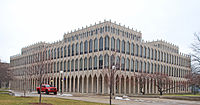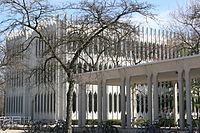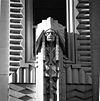Minoru Yamasaki
- ️Sun Dec 01 1912
| Minoru Yamasaki | |
|---|---|
| Born | December 1, 1912 Seattle, Washington, United States |
| Died | February 7, 1986 (aged 73) Bloomfield Hills, Michigan, United States |
| Nationality | American |
| Alma mater | University of Washington, New York University |
| Awards | American Institute of Architects' First Honor Award |
| Work | |
| Buildings | The Twin Towers of the World Trade Center |
| Projects | World Trade Center |
| Design | Inspiration by Gothic architecture and usage of narrow vertical windows |
Minoru Yamasaki (山崎 實 Yamasaki Minoru?, December 1, 1912 – February 7, 1986) was a Japanese-American architect, best known for his design of the twin towers of the World Trade Center, buildings 1 and 2.[1] Yamasaki was one of the most prominent architects of the 20th century. He and fellow architect Edward Durell Stone are generally considered to be the two master practitioners of "New Formalism."[2]
Contents
Biography
Yamasaki was born in Seattle, Washington, a second-generation Japanese American, son of John Tsunejiro Yamasaki and Hana Yamasaki.[3] He grew up in Auburn, Washington and attended Auburn Senior High School.[4] He enrolled in the University of Washington program in architecture in 1929, and graduated with a Bachelor of Architecture (B.Arch.) in 1934.[5] During his college years, he was strongly encouraged by faculty member Lionel Pries. He earned money to pay for his tuition by working at an Alaskan salmon cannery.[6]
After moving to New York City in the 1930s, he enrolled at New York University for a master's degree in architecture and got a job with the architecture firm Shreve, Lamb and Harmon, designers of the Empire State Building. In 1945, Yamasaki moved to Detroit, where he was hired by Smith, Hinchman, and Grylls.[7] The firm helped Yamasaki avoid internment as a Japanese-American during World War II, and he himself sheltered his parents in New York City.[8] Yamasaki left the firm in 1949, and started his own partnership.[7] One of the first projects he designed at his own firm was Ruhl's Bakery at 7 Mile Rd. and Monica St.[9] In 1964 Yamasaki received a D.F.A. from Bates College.
Yamasaki was first married in 1941 and had two other wives before marrying his first wife again in 1969. He died of stomach cancer[citation needed] in 1986. His firm, Yamasaki & Associates, closed on December 31, 2009.[10]
Works
His first significant project was the Pruitt–Igoe housing project in St. Louis, Missouri, 1955. Despite his love of Japanese traditional design, this was a stark, modernist concrete structure. The housing project experienced so many problems that it was demolished in 1972, less than twenty years after its completion. Its destruction is considered by some to be the beginning of postmodern architecture. [11]
He also designed several "sleek" international airport buildings and was responsible for the innovative design of the 1,360 foot (415 m) towers of the World Trade Center, for which design began in 1965, and construction in 1972. Many of his buildings feature superficial details inspired by the pointed arches of Gothic architecture, and make use of extremely narrow vertical windows. This narrow-windowed style arose from his own personal fear of heights.[12]
Yamasaki was an original member of the Pennsylvania Avenue Commission, which was tasked with restoring the grand avenue in Washington, D.C., but resigned after disagreements and disillusionment with the design by committee approach.[13]
After teaming up with Emery Roth and Sons on the design of the World Trade Center, they teamed up again on other projects including new defense buildings at Bolling Air Force Base in Washington, D.C.[14]
Structures designed by Minoru Yamasaki
- Federal Reserve Bank of Chicago Detroit Branch Building annex, Detroit, Michigan, 1951
- Pruitt–Igoe housing project, St. Louis, Missouri,[15] 1954 (demolished in 1972)
- Gratiot Urban Redevelopment Project, Detroit, Michigan, 1954[15]
- University School, Grosse Pointe, Michigan, 1954[15]
- Military Personnel Records Center, St. Louis, Missouri, 1955
- Land's Pharmacy, currently Know Advertising, Royal Oak, MIchigan, 1955
- United States Consulate in Kobe, Japan 1955[5]
- Lambert-St. Louis International Airport main terminal, 1956[15]
- Birmingham Unitarian Church, Bloomfield Hills, Michigan, 1956
- McGregor Memorial Conference Center, Wayne State University, Detroit, 1957
- College for Creative Studies, Yamasaki Building, Detroit, 1957
- Michigan State Medical Society building, East Lansing, Michigan, 1959[16]
- Prentis Building and DeRoy Auditorium Complex, Wayne State University, Detroit, 1959 [17]
- Reynolds Metals Regional Sales Office, Southfield, Michigan, 1959[15]
- United States Pavilion, World Agricultural Fair, New Delhi, India, 1959[15]
- Dhahran International Airport - Civil Air Terminal, Saudi Arabia, 1961 [5]
- Carleton College buildings: Olin Hall of Science 1961, Goodhue Dormitory 1962, West Gym 1964, Cowling Rec Center 1965, Watson Hall 1966 and 1961 4th Floor addition to Myers Hall, Northfield, Minnesota[18]
- master plan for Wascana Centre and buildings for the University of Regina, including the Dr. John Archer Library, Regina, Saskatchewan, 1961–1967
- Pacific Science Center[5][15] (formerly known as the Federal Science Pavilion for Seattle's Century 21 World's Fair), Seattle, Washington, 1962
- Irwin Library, Butler University, Indianapolis, Indiana, 1963[19]
- Michigan Consolidated Gas Building - (Now One Woodward Avenue), Detroit, Michigan, 1963[15]
- Daniell Heights married student housing, Michigan Technological University, Houghton, Michigan, 1963
- Oberlin Conservatory of Music (photo), Oberlin College, Ohio, 1963
- IBM Building, Seattle, Washington, 1963
- Queen Emma Gardens, Honolulu, Hawaii, 1964[15]
- North Shore Congregation Israel, Glencoe, Illinois 1964
- Northwestern National Life Insurance Co. Building (now ING), Minneapolis, Minnesota, 1964
- Robertson Hall, Woodrow Wilson School of Public and International Affairs, Princeton University, 1965[15]
- Behavioral Sciences Building (William James Hall) - Harvard University,[5] 1965
- Century Plaza Hotel, Los Angeles, California, 1966
- King Building, Oberlin College, 1966
- Quo Vadis Entertainment Center, Westland, Michigan, 1966 (deconstruction beginning in March 2011)
- M&T Bank Center, Buffalo, New York, 1967[15]
- Japan Center, San Francisco, California, 1968
- Eastern Airlines Terminal, (Logan Airport Terminal A) Boston, Massachusetts,[15] 1969 (Demolished 2002).[20]
- World Trade Center Tower 1, Tower 2, Building 4, 5 and 6, 1970 and 1971, New York City (destroyed on September 11, 2001 by terrorist attack)
- Montgomery Ward Corporate Headquarters Tower, Chicago, Illinois, 1972 (converted into high-rise residential condominiums in 2005)
- Temple Beth El, Bloomfield Township, Michigan 1974[15]
- Century Plaza Towers, Los Angeles, 1975[15]
- Tulsa Performing Arts Center, Tulsa, Oklahoma, 1976[15]
- One Government Center, Toledo, Ohio, 1976[21]
- Steinman College Center, Franklin and Marshall College, Lancaster, Pennsylvania, 1976
- Bank of Oklahoma, Tulsa, Oklahoma, 1977[15]
- Rainier Bank Tower, Seattle, Washington, 1977[15]
- Federal Reserve Bank of Richmond, Richmond, Virginia, 1978 [15]
- Horace Mann Educators Insurance Co., Springfield, Illinois, 1979[15]
- 100 Washington Square, Minneapolis, Minnesota, 1981
- Saudi Arabian Monetary Agency Head Office, Riyadh, Saudi Arabia, 1981[15]
- Founder's Hall, Shinji Shumeikai, Shiga Prefecture, Japan, 1982[15]
- Eastern Province International Airport, Saudi Arabia, 1985[15]
- Istanbul Cevahir, Istanbul, Turkey, designed 1987, constructed 1997-2005
- Torre Picasso, Madrid, Spain, 1988
- Columbia Center, Troy, Michigan, 1989–2000
- Colonnade Plaza (formerly the Mutual of Omaha Bank Building), Miami, Florida
- John Marshall Middle School, Westland, Michigan
- Lincoln Elementary School, Livonia, Michigan (Demolished mid-1980s)
- Medical College of Ohio Hospital and Medical College of Ohio, now University of Toledo
- Pahlavi University in Shiraz, Iran[5]
Honors
- Yamasaki was elected as a Fellow in the American Institute of Architects in 1960.
- Yamasaki won the American Institute of Architects' First Honor Award three times.[5]
See also
References
- ^ Justin Davidson (August 27, 2011). "The Encyclopedia of 9/11: Yamasaki, Minoru: An architect whose legacy didn’t work out as he’d planned". New York. http://nymag.com/news/9-11/10th-anniversary/minoru-yamasaki/.
- ^ "New Formalism". Performing Arts Center of Los Angeles County. http://www.musiccenter.org/about/formalism.html. Retrieved March 2011.; excerpting from HABS documentation: "Los Angeles Music Center". Historic American Building Survey. http://memory.loc.gov/cgi-bin/query/D?hh:1:./temp/~ammem_BvpF::.
- ^ Crowley, Walt (March 3, 2003). Yamasaki, Minoru (1912-1986), Seattle-born architect of New York's World Trade Center. HistoryLink.org - The Free Online Encyclopedia of Washington State History. Retrieved July 22, 2010.
- ^ Casey J. Olson (Sep 8, 2011), World Trade Center architect Minoru Yamasaki wanted 'living symbol' for humanity, Federal Way Mirror, http://www.pnwlocalnews.com/south_king/fwm/news/129488198.html, retrieved 2011-09-09
- ^ a b c d e f g Esterow, Milton (September 21, 1962). "Architect Named for Trade Center". The New York Times.
- ^ "Center Will Reflect Architectural Collaboration". The New York Times. January 19, 1964.
- ^ a b Huxtable, Ada Louise (November 25, 1962). "Pools, Domes, Yamasaki - Debate". The New York Times.
- ^ [1]
- ^ Interview with owner's daughter. Original architectural drawings donated to the University of Michigan.
- ^ Gallagher, John. "A Once Eminent Firm Meets a Bitter End", Architectural Record, 28 January 2010. Retrieved March 6, 2010.
- ^ Justin Davidson (August 27, 2011). "The Encyclopedia of 9/11: Yamasaki, Minoru: An architect whose legacy didn’t work out as he’d planned". New York. http://nymag.com/news/9-11/10th-anniversary/minoru-yamasaki/.
- ^ Lipton, Eric (2003). City in the sky: the rise and fall of the World Trade Center. Macmillan. p. 109. ISBN 978-0805074284. http://books.google.com/books?id=yE1Pyui4GpkC&printsec=frontcover#v=onepage.
- ^ Huxtable, Ada Louise (February 2, 1964). "N.Y.C. Architectural Ups and Downs". The New York Times.
- ^ Robbins, William (March 26, 1967). "2 Firms Are Welding Abilities to Plan World Trade Center". The New York Times.
- ^ a b c d e f g h i j k l m n o p q r s t u v Vivian M. Baulch (August 14, 1998). "Minoru Yamasaki, world-class architect". The Detroit News. http://info.detnews.com/redesign/history/story/historytemplate.cfm?id=206. Retrieved 2007-11-23.
- ^ "MSMS". http://www.msms.org/. Retrieved 2010-01-14.
- ^ "Helen L. DeRoy Auditorium". Digital Imaging Project. http://www.bluffton.edu/~sullivanm/wayne/wayne3.html. Retrieved January 14, 2011.
- ^ Carleton College Facilities Management (undated). "Historical Building Information". Carleton College. http://apps.carleton.edu/campus/facilities/property/historical/. Retrieved 2007-07-10.
- ^ "Yamasaki, Minoru". architectureka.com. 2009. http://architectureka.com/yamasakiminoru.html. Retrieved 4 March 2010.
- ^ Massport (undated). "2002 EDR Logan International Airport" (PDF). Massport. http://www.massport.com/about/pdf/09_Mitigation.pdf. Retrieved 2007-07-11.
- ^ "Michael DiSalle Government Center, Toledo, Ohio". http://www.emporis.com/application/?nav=building&lng=3&id=128237. Retrieved January 14, 2011.
Other references
- Yamasaki, Minoru, A Life in Architecture, Weatherhill, NY 1979 ISBN 0834801361
- Nobel, Philip, Sixteen Acres: The rebuilding of the World Trade Center site, Granta, London 2005 ISBN 1-86207-713-4
External links
- GreatBuildings.com listing
- Minoru Yamasaki interview, [ca. 1959 Aug.] - Archives of American Art
- Hadley, Jane (September 13, 2001), "Seattle architect created trade center as peace symbol", The Seattle Post-Intelligencer, http://www.seattlepi.com/local/38737_architect13.shtml
- 18 Images of Minoru Yamasaki from Virtual Motor City Collection at Wayne State University Library
| v · d · eWorld Trade Center | |
|---|---|
| World Trade Center Complex | |
| 2001–present |
World Trade Center site · One World Trade Center · Two World Trade Center · Three World Trade Center · Four World Trade Center · Five World Trade Center · 7 World Trade Center · National September 11 Memorial & Museum · The Mall at the World Trade Center · PATH station |
| Terrorist Attacks | |
| Alternative Proposal | |
| Biographies |
Minoru Yamasaki · Larry Silverstein · Austin J. Tobin |









